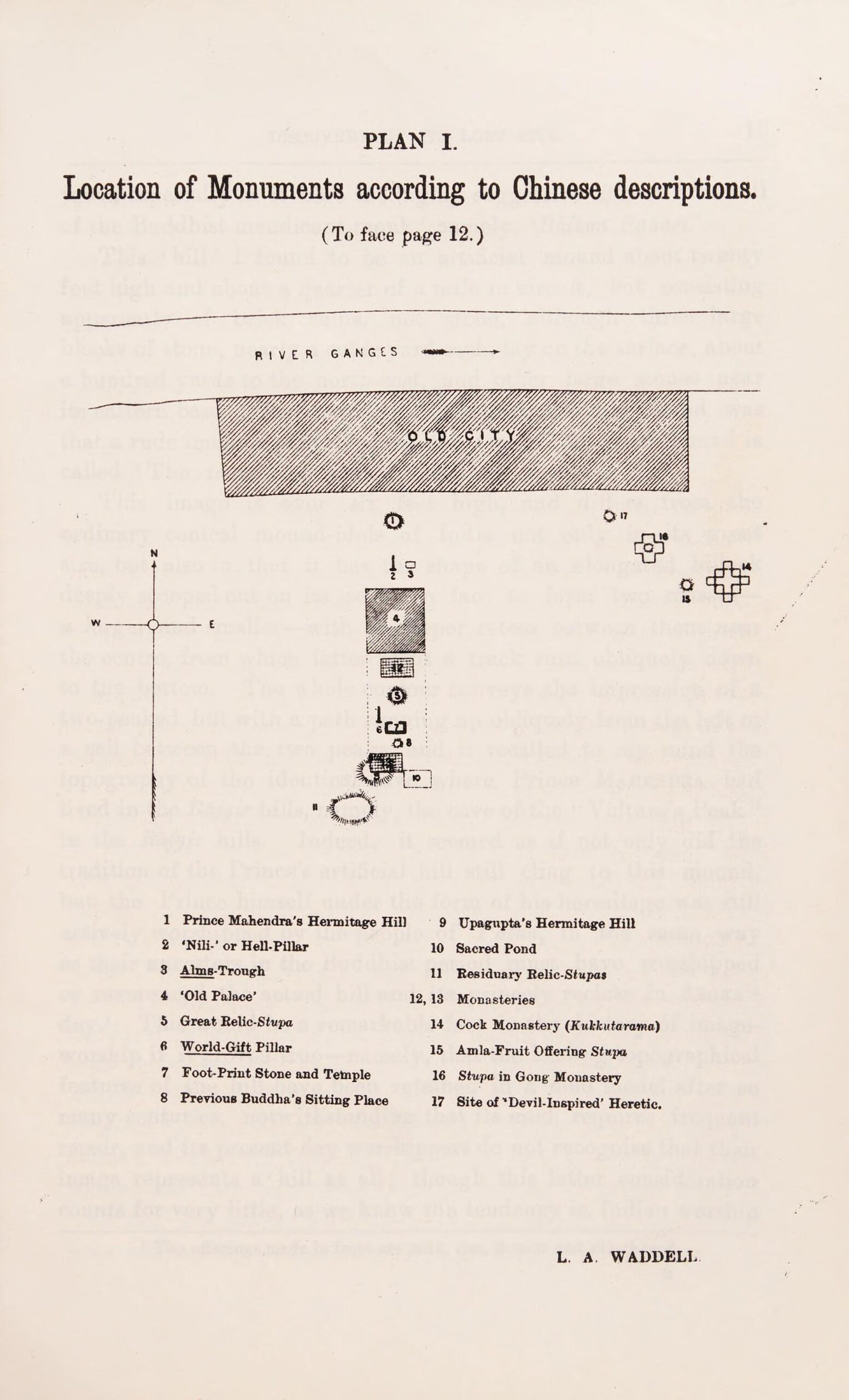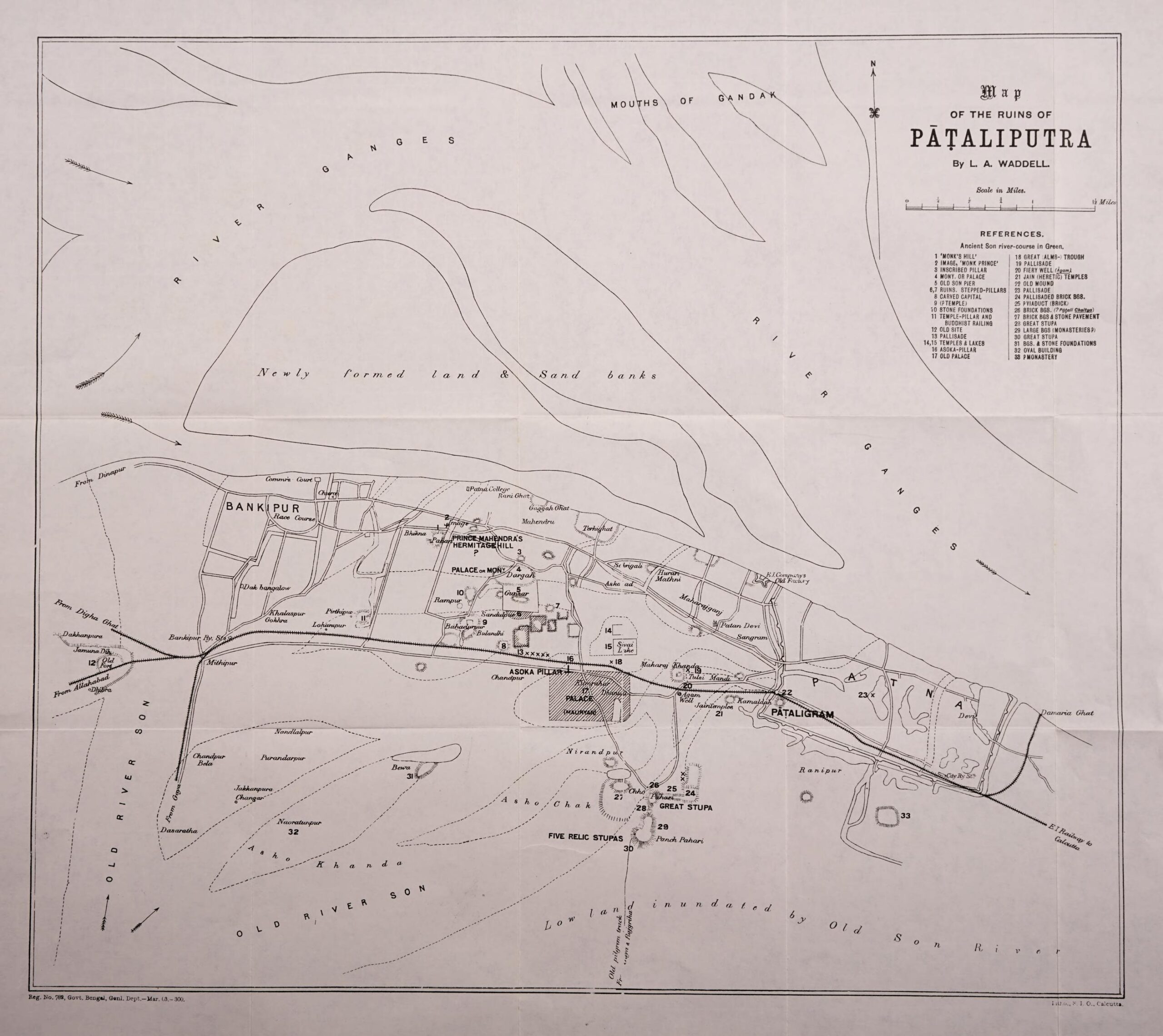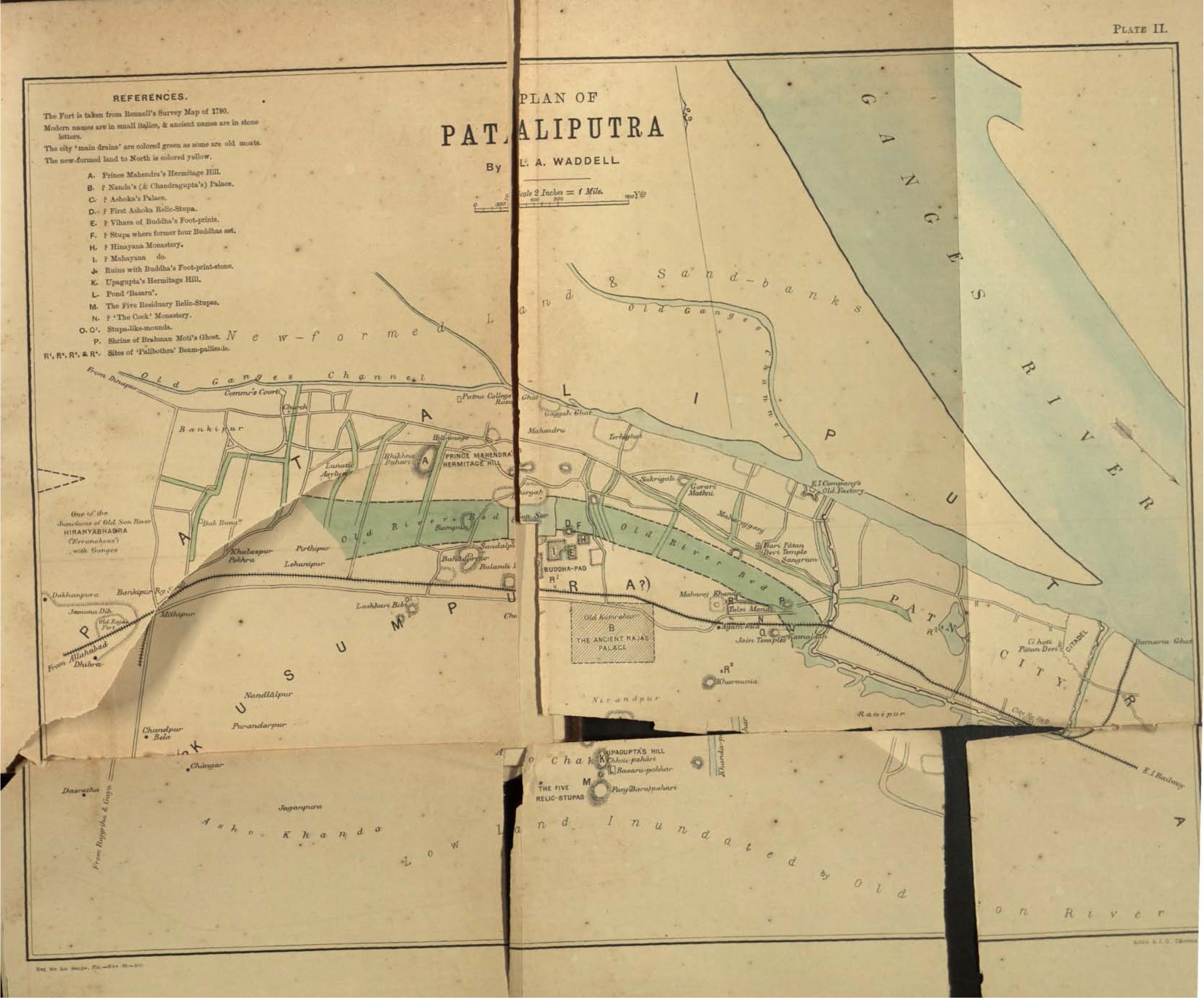Kukkutarama monastery was situated in Patliputra and had support and patronage of Emperor Ashoka. Third Buddhist Coulcil was held in this monastery. In his old age, when stopped by the heir-apparent in making donations, Ashoka had sent the half-amalaka (a fruit used as a medicine in India) as his last gift to be divided among the monks of this monastery.
IMPORTANCE:
- Third Buddhist Council was held in famous Kukkutarama monastery of Patliputra in the 17th year of Ashok’s reign under his patronage. The Council had lasted for nine months.
- The doctrinal issues of Pancavatthu (Five-Points) that had caused a split in the monastic establishment was resolved here.
- Kukkutarama Vihara of Patallputra was at the helm of affairs during Ashoka’s reign.
- In his old age, when stopped by the heir-apparent (his grandson, Samprati, the son of Kunala who under the influence of the high officials who had usurped all power), the great Ashoka had sent the half an amalaka (a fruit used as a medicine in India) on an earthen plate as his last gift to be divided among the monks of this monastery. The great Amalaka Stupa by the side of the Sangharama commemorated this event.
PAST EXPLORATIONS:
| “Hwen Thsang says further—“ to the south-east of the city was Asoka’s Kukkutarama monastery ‘with a stupa. To the south-east of Patna there is yet a small brick mound ; its name has escaped me, but it is clearly the ruins of Asoka’s Kukkutarama monastery, and would probably be worth excavating“. – an excerpt from Report of A Tours Through The Bengal Provinces Of Patna, Gaya, Mongir, And Bhagalpur, page 27, J.D. Beglar, 1872 |
| ”Kukkutarama, South-east of Patna To the south-east of the old city was the Sangharama of Kukkutarama, which was built by Asoka Raja, as a sort of first-fruit and a pattern of majestic construction and lofty building, when he became a believer in the doctrine of the Buddha. In the Asokavadana (Mitra’s Indo-Aryans, Volume II, page 408), Kukkuta-Vihara is referred to as in a garden, called Upakanthikarama, on the right bank of the Ganges, near the city of Patliputra. This monastery was long in ruins, probably since 436 AD, when Arhat Kasypa left it for Tibet, but the foundation wall existed at the time of Hiusen Tsiang’s visit. Amalaka Stupa By the side of the Sangharama was a great stupa, called Amalaka (ribbed melon), which was used as a medicine in India. Asoka built this stupa, when he recovered from a long sickness, as mark of gratitude to the Sthavira, who blessed him at the time his majesty presented an Amalaka fruit, the only article he possessed at the time of his poverty. Ghanta Stupa North-west of the Amalaka was another stupa, known as ‘’establishing the Ghanta,’’ in commemoration of striking the bell, after twelve years’ silence, by Aryadeva, who defeated the heretics of the Vaisali sect. This Ghanta stupa was in the middle of an old Sangharama. To the north of it was the old foundation of a ruined house where a Brahman under the influence of a spirit, and within a curtain, used to defeat all learned man, until Asvaghosa, versed in the three vehicles, little, great and middle, silenced him.” – an excerpt from pages 16-17, Report on the excavations on the ancient sites of Pataliputra in 1896-97 by P.C. Mukharji. |
| ”The remaining chief monuments and sites outside the palace are the Kukkutarama monastery, and its surrounding (see plan I), the site of the ‘heretics.’ The two oldest monasteries of Pataliputra appear to have been ‘The Monastery of the Cock’(Kukkutarama)1 and the Asokarama.2 The former of these, which lay to the south-east of the city, is also said to have been built by Asoka3 and was “a pattern of majestic construction. He gathered there a thousand priests,” and here it was that in the closing days of his life, when he seems to have been deposed from power, he, poverty-struck, offered half an Amlaka fruit4 to the priests, which event was afterwards marked by a stupa, The location of this building, as I previously indicated in 1892, seems about 33 on the map, where there are several mounds not yet explored.” – an excerpt from page 57, Report on the excavations at Pataliputra (Patana) by Waddell, L.A. Published in 1903 |
HISTORY:
The origin of Kukkutarama (Rooster’s Park or Cock’s Monastery) is said to be a small monastery built by a lay-supporter Kukkutasethi at the place where Ananada preached discourses while visiting Patligram after death of Lord Buddha1. In due course, this was renovated and expanded greatly by Emperor Ashoka on being inspired by the ideas of Lord Buddha. This was much favoured by the emperor hence it grew to become a large monastic complex soon.
During Ashoka’s time, the majestic Kukkutarama Sangharama was a very influential monastery situated to the south east of the capital city of Patliputra, the citadel of Buddhism in the olden times. This was the first fruit of Ashoka’s zeal as Buddhist and accommodated a thousand monks2.
Kukkutarama Vihara of Patallputra was at the helm of affairs during Ashoka’s reign due also to the doctrinal issues of Pancavatthu (Five-Points) pertaining to loss of dignity for the Arhats propounded and introduced to the pupils by an infamous ‘monk’ named Mahadev3,4 who incidentally was ordained and taught at Kukkutarama. This controversy had caused a split in the monastic establishment 3,4,5.
Kukkutarama was the setting of the nine month long third Buddhist Council held in 17th year of Ashok’s reign in Patliputra (in c. 247 BC) under overall supervision of the Emperor to resolve the doctrinal issues. Over 1000 monks convened under the guidance of Moggaliputta Tissa, removed the divisive elements and Abhidhamma was finalised. Shortly after completion of the Council, Ashoka sent out enlightened messengers to propagate Dhamma to different countries and regions including Burma and Sri Lanka1.
List of enlightened Missionaries Sent by Emperor Ashoka to propagate Dhamma
| Name of Missionary | Country/region sent |
| Majjhantika/Mahyantika | Kashmir and Gandhara |
| Mahadeva Thera | Mahismandala (Mysore) |
| Rakkhita Thera | Vanavasi (Northern Kanara, South India) |
| Yona Dhammarakkhita | Aparantaka (Northern Gujarat Kathiawar, Kachchh and Sindh) |
| Mahadhammarakkhita | Maharattha (Maharashtra) |
| Maharakkhita | Yona (Greece) |
| Majjhima | Himavanta (Himalayan Region) |
| Sona and Uttara | Suvarnabhumi (Myanmar/Thailand) |
| Mahindra and Sanghamitra | Lakshadweep & Srilanka |
In his old age, the Emperor Ashoka had resolved to make large donations to this monastery however when stopped by the heir-apparent to do so he sent the half-amalaka (a fruit used as a medicine in India) as his last gift to the Kukkutarama monastery to be divided among the monks2.
The famous Amalaka Stupa and the Gong Call stupa were in the vicinity of this monastery. The great Amalaka Stupa (named after a fruit used as a medicine in India) was by the side of the Sangharama. It was erected by the Emperor Ashoka as a mark of gratitude or was built to commemorate his death. The Gong Call stupa was situated in the north-west of the Amalaka Stupa. Ghanta was sounded here. The name was due to the Buddhist monk Deva, a pupil of the great Nagarjuna, striking the ghanta or gong as a challenge to the heretics.
The monastery is also associated with Vitasoka, the younger brother of Ashoka who lived in Kukkutarama monastery after leaving hermit hill monastery2.
Further, the stories of the legend of Ashoka as these appear in the text Divydvaddna were compiled for the first time at Pataliputra, in the Kukkutarama Monastery6.
The influence of this monastery declined after Mauryas, especially after the demise of King Ashoka. The Monastery is said to be destroyed by Pushyyamitra. According to Diiyavadana, ”Pushyamitra was bent on rivalling Asoka in power and fame and began to destroy the monasteries built by Ashoka. He first destroyed the Kukkutarama-vihara, situated near Pataliputra; but it was said to be saved by a miracle”7.
The Chinese pilgrim Hiuen Tsiang (or Xuan Zang) visited the city of Patliputra in the seventh century AD. As per the travel account left by him, only the foundations of the once celebrated Kukkutarama monastery (Cock Monastery) were surviving at the time of his visit. Rest of the structure lay in ruins8. According to accounts left by him, the monastery and the stupas were situated in the south-east of the city. He saw some evidences of the monastery but he could not find any trace of the famous Amalaka Stupa and the Gong Call stupa. Both stupas had completely vanished by the time of Hiuen Tsiang’s visit though these were in good condition when Fa-shien visited Patliputra 200 years earlier.
J.D. Beglar in his report of 1872 had noted a small brick mound in a location south-east of Patna which, according to him, clearly was the ruins of Asoka’s Kukkutarama monastery9.
L.A. Waddell in his report of 1892 on discovery of ancient city of Patliputra, had observed that ‘’the site of Kukkutarama Monastery may now be occupied by the village of Tulsi Mandi’’ 10.
With no physical trace of the Kukkutarama Monastery of Patliputra left now, sadly, the story of Kukkutarama is a classic example of the euphemism ‘gone with the wind’. But Kukkutarama still lives in the hearts and minds of devotees and admirers of Lord Buddha and Emperor Ashoka, for example, in the form of Kukkutarama Sutta of Sri Lankan tradition.
| Time-line of Kukkutarama Monastery of Patliputra |
| c. 480 BC : Kukkutasethi: The monastery was originally built by a lay-supporter Kukkutasethi at the place where Ananada preached discourses while visiting Patligram after death of Lord Buddha. |
| c. 260 BC – 250 BC : Emperor Ashoka: Developed to a grand scale by the Emperor Ashoka. The majestic Kukkutarama Sangharama was a very influential monastery during Ashoka’s time |
| c. 247 BC : Emperor Ashoka & Moggaliputta Tissa: The third Buddhist Council held in 17th year of Ashok’s reign in Kukkutarama Monastery of Patliputra under overall supervision of the Emperor Ashoka to resolve the doctrinal issues of Pancavatthu (Five-Points) under the guidance of Moggaliputta Tissa. |
| c. 180 BC : Pushyyamitra Sunga: After demise of Emperor Ashoka, Kukkutarama Vihara was allegedly destroyed by Pushyyamitra Sunga but the monastery was said to be saved by a miracle. |
| 7th Century AD : Hiuen Tsiang (or Xuan Zang): At the time of his visit to the city of Patliputra, only the foundations of the once celebrated Kukkutarama monastery were surviving, rest of the structure lay in ruins. |
| 7th Century AD – 18th Century AD : The Era of Great Cultural Paralysis |
| 1872 AD : J.D. Beglar: He noted a small brick mound in a location south-east of Patna which, according to him, clearly was the ruins of Kukkutarama monastery. |
| 1892 AD : L.A. Waddell: In his report on discovery of ancient city of Patliputra, had observed that ‘’the site of Kukkutarama Monastery may now be occupied by the village of Tulsi Mandi. |
| 2021 : Umesh Prasad: As on 08 December 2021, the exact location could not be ascertained. Unfortunately, no one in modern day Patna seems to know anything about the legendry Kukkutarama Monastery of Patliputra. |
ARCHAEOLOGICAL FINDS
The authour could not find any report of archaeological finds in academic or journalistic resources avaialble online.
GEOGRAPHICAL LOCATION:
With no trace left, the Monanstery seems to be completely vanished now. No exact location could be ascertained as on 09 Decemebr 2021.
| Country | India |
| State | Bihar |
| District | Patna |
| Sub-division | ? |
| Block | ? |
| Village | ? Tulsi Mandi |
| Postal Code | ? |
| Coordinates | ? Approx., Lat 25.6000 Long 85.1167* |
| Google map link | ? |
* Mapping Buddhist Monasteries – Kukkutārāma monastery, (near) Patna, Bihar, IN



GOOGLE MAP:
Not Available
REFERENCES:
- Along the Path: The Meditator’s Companion to the Buddha’s Land. By Kory Goldberg, Michelle Decary 2012. Pages 197-198.
- Rulers of India: Asoka the Buddhist Emperor of India
by VA Smith | pdf file | Asoka, the Buddhist emperor of India - An Asian Story of the Oedipus Type by Victor A. Mair. Asian Folklore Studies. Vol. 45, No. 1 (1986), pp. 19-32 (14 pages).
- Buddhist Sects and Sectarianism. By Bibhuti Baruah
- Samghabheda and Nikyabheda : A critical study of the schism, origin and formation of sects and sectarianism in early Buddhism. By LC Bhikkhu
- Asoka and Buddhism–A Reexamination by AL Basham.
- Indigenous States Of Northern India (circa 200 B.c. To 320 A.d.). by Bela Lahiri 1974 | pdf file | page 33
- The Decline of Pātaliputra with Special Reference to Geograhical Factors. by Rajeshwar Prasad Singh page 57
- Report Of A Tours Through The Bengal Provinces Of Patna, Gaya, Mongir, And Bhagalpur,…by by Beglar, J. D. | page 51 |
- Discovery of the exact site of Asoka’s classic capital by Waddell, L.A. | pdf file pp 13-14.
BIBLIOGRAPHY:
- Aśoka: Master of Good Means and Merit Maker. The Chapter Five of the book The Legend of King Asoka: A Study and Translation of the Asokavadana. pp. 134-166.
- Kukkutārāma monastery, (near) Patna, Bihar
- Kukkutārāma, Pātaliputta. Pali Canon
- Kukkutārāma
SELECTED VIDEOS
Kukkutarama Sutta (in Sinhala) by Ven Thalalle Chandakiththi Thero
https://web.archive.org/web/20221210164420/https://www.youtube.com/watch?v=HvfxjvmcVKk
***
